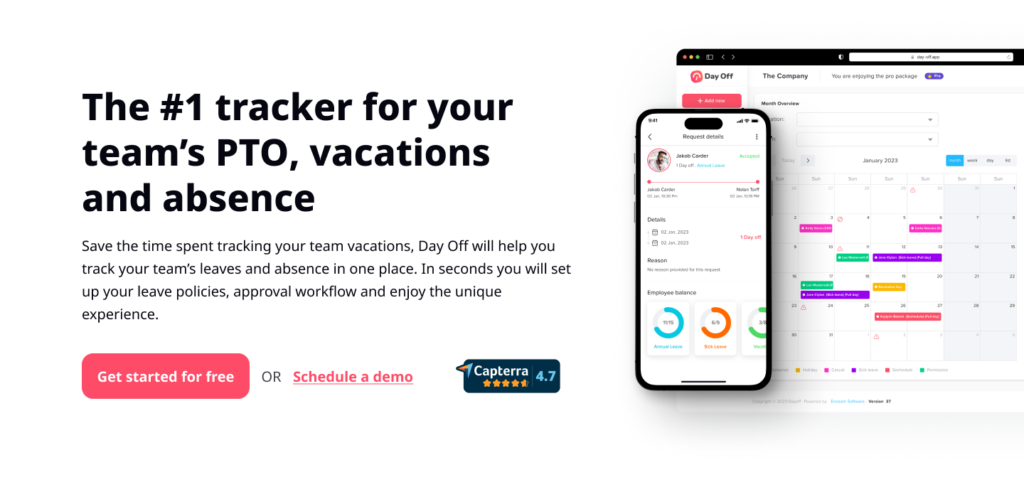Paid Time Off (PTO) accrual is a very important part of employee benefits. It helps balance work and personal life. It’s important for HR people and workers to really understand PTO accrual for a smooth and happy workplace. This guide looks closely at PTO accrual, how it works, its good points, and how to handle it well. We will go into detail about this system to help make things better for both the company and its employees. Knowing about PTO accrual is key to keeping a workplace where people are happy and work well.
What Does PTO Mean?
PTO, or Paid Time Off, is a policy that combines vacation, sick time, and personal time into a single bank of days that employees can use to take paid time off from work. This system allows employees more flexibility in how they use their time off, as opposed to traditional systems where sick days, vacation days, and personal days are separately categorized.
Under a PTO system, employees typically accrue hours of paid time off based on their tenure at the company and the number of hours worked. For example, an employee might earn a certain number of PTO hours for every week or month of work. They can then use these hours when they need a break, are sick, or wish to take a vacation.
The main advantage of PTO is that it simplifies the process of taking time off and gives employees more freedom in using their leave days. It’s up to the employee to decide how to use their PTO, whether it’s for relaxation, dealing with personal matters, or health-related issues. This approach is increasingly popular as it is seen as more accommodating to the diverse needs and lifestyles of employees.
Accrual Rates:
These rates determine how much PTO an employee earns. For example, an employee might accrue one hour of PTO for every 30 hours worked. These rates can vary based on the company’s policy, employee’s tenure, and other factors.
The Mechanics of PTO Accrual
Calculating PTO accrual and understanding rollover policies are key components of an effective PTO system. Let’s delve deeper into these aspects:
1. Calculating Accrual:
Accrual Periods: PTO accrual is based on specific periods, which can be weekly, bi-weekly, or monthly. This means that at the end of each period, employees earn a certain amount of PTO hours. For example, in a weekly accrual system, an employee might earn a set number of hours of PTO at the end of each week worked.
2. Determining Accrual Rates:
The rate at which employees accrue PTO often depends on factors such as their tenure with the company and their employment status (full-time or part-time). For instance, a new employee might accrue PTO at a slower rate than someone who has been with the company for several years.
3. Maximum Cap:
Many organizations set a maximum cap on PTO accrual. This cap is the maximum amount of PTO an employee can accumulate. Once they reach this cap, they will not accrue more PTO until they use some of their stored time. This policy encourages employees to take time off and prevents the accumulation of excessive leave balances.
Rollover Policies:
1. Use-It-Or-Lose-It Policy:
Under this policy, employees must use all their accrued PTO within a given year. If they don’t, they lose any unused time at the end of the year. This policy encourages employees to take advantage of their PTO and helps the company manage leave balances more effectively.
2. Rollover Policy:
Some companies allow employees to roll over unused PTO to the next year. There may be a limit to how much PTO can be rolled over, preventing excessively large balances. This option is often valued by employees as it provides more flexibility in planning extended vacations or sabbaticals.
3. Payout Options:
In certain cases, companies offer a payout for unused PTO at the end of the year, or upon leaving the company. This can be an attractive benefit, adding to the overall compensation package.
Effective Management of PTO Accrual and Rollover Policies
To manage these aspects effectively, clear communication of policies is essential. Employees should be well informed about how they accrue PTO, the maximum cap (if any), and the company’s rollover policy. Additionally, using a reliable system or software for tracking PTO accrual and usage can help both employees and HR managers keep track of leave balances accurately.
Overall, well-structured PTO accrual and rollover policies can lead to a more satisfied and well-rested workforce, contributing to higher productivity and employee morale.
Establishing an Efficient PTO Accrual System
Crafting an Equitable Policy:
Creating a Transparent and Just Policy: It’s crucial to develop a PTO policy that is clear and impartial. This involves looking at what is common in your industry and making sure your policy is in line with those norms. The policy should also reflect your company’s core values and operational needs. This might mean considering the unique demands of your workforce and the nature of their work.
Policy Tailoring: Each organization is unique, so it’s important to tailor your PTO policy to fit your specific workplace environment. This includes deciding on accrual rates, maximum accrual limits, and whether PTO can be carried over or paid out.
Effective PTO Accrual Management
1. Systematic Tracking and Oversight:
- Establishing a Robust Tracking System: It’s essential to have a reliable method in place for monitoring PTO accrual. This could be through sophisticated HR software or even a manual system for smaller organizations. For example, using a tool like “Day Off Leave Tracker” can streamline this process. Such systems allow for real-time tracking of accrued leave, simplifying management for both HR and employees.
- Proactive Monitoring for Effective Staffing: Regularly keeping tabs on PTO accrual is important for managing workforce availability. This ensures that staffing levels are maintained and helps in forward planning to cover for employee absences.
2. Resolving Accrual Issues:
- Creating a Transparent Dispute Resolution Process: Set up a transparent procedure for addressing any issues or disagreements related to PTO accrual. This process should be straightforward and easily accessible to all employees.
- Fostering Open Communication: Implementing policies like regular check-ins or an open-door approach encourages employees to voice their concerns regarding PTO. This can be instrumental in resolving disputes quickly and maintaining trust in the PTO system.
Example of a Tracking Tool – ‘Day Off Leave Tracker‘:

For instance, a system like Day Off Leave Tracker can serve as an effective example. This type of tool not only tracks accrued leave but can also provide clarity and transparency, reducing potential conflicts over PTO calculations.
Day Off vacation Tracker is a tool designed to manage and track employee Paid Time Off (PTO) accruals. It functions by automatically calculating the amount of PTO accrued by each employee over a set period, such as weekly, bi-weekly, or monthly. As employees work and accumulate hours, the system updates their PTO balances in real-time, ensuring that the data is always current and accurate.
This tool typically allows both employees and managers to view PTO balances, providing transparency in how much leave has been earned and how much is available for use. When an employee takes a day off, the tracker deducts the appropriate amount from their accrued balance. Additionally, Day Off can often be configured to align with specific company policies, such as maximum accrual caps or rollover rules, making it a versatile solution for PTO accrual management.
Conclusion
PTO accrual is more than just a policy; it’s an investment in your employees’ well-being and your organization’s health. An effective PTO accrual system can lead to a more engaged, satisfied, and productive workforce. By understanding the nuances of PTO accrual and implementing a thoughtful, well-communicated policy, organizations can foster a positive work environment that values and respects employee time.
